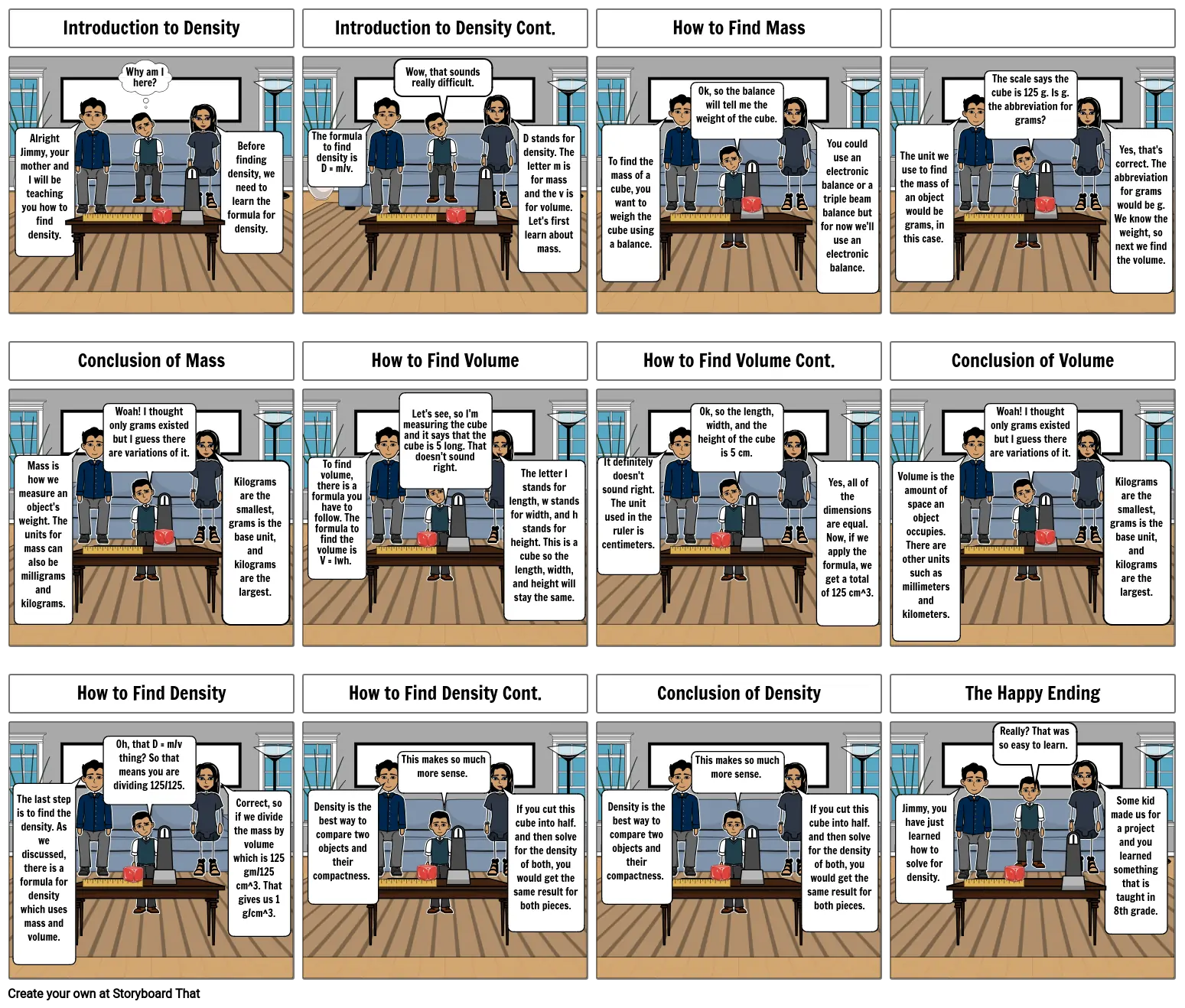Density Project Comic Strip

Storyboard Text
- Introduction to Density
- Alright Jimmy, your mother and I will be teaching you how to find density.
- Why am I here?
- Before finding density, we need to learn the formula for density.
- Introduction to Density Cont.
- The formula to find density is D = m/v.
- Wow, that sounds really difficult.
- D stands for density. The letter m is for mass and the v is for volume. Let's first learn about mass.
- How to Find Mass
- To find the mass of a cube, you want to weigh the cube using a balance.
- Ok, so the balance will tell me the weight of the cube.
- You could use an electronic balance or a triple beam balance but for now we'll use an electronic balance.
- The unit we use to find the mass of an object would be grams, in this case.
- The scale says the cube is 125 g. Is g. the abbreviation for grams?
- Yes, that's correct. The abbreviation for grams would be g. We know the weight, so next we find the volume.
- Conclusion of Mass
- Mass is how we measure an object's weight. The units for mass can also be milligrams and kilograms.
- Woah! I thought only grams existed but I guess there are variations of it.
- Kilograms are the smallest, grams is the base unit, and kilograms are the largest.
- How to Find Volume
- To find volume, there is a formula you have to follow. The formula to find the volume is V = lwh.
- Let's see, so I'm measuring the cube and it says that the cube is 5 long. That doesn't sound right.
- The letter l stands for length, w stands for width, and h stands for height. This is a cube so the length, width, and height will stay the same.
- How to Find Volume Cont.
- It definitely doesn't sound right. The unit used in the ruler is centimeters.
- Ok, so the length, width, and the height of the cube is 5 cm.
- Yes, all of the dimensions are equal. Now, if we apply the formula, we get a total of 125 cm^3.
- Conclusion of Volume
- Volume is the amount of space an object occupies. There are other units such as millimeters and kilometers.
- Woah! I thought only grams existed but I guess there are variations of it.
- Kilograms are the smallest, grams is the base unit, and kilograms are the largest.
- How to Find Density
- The last step is to find the density. As we discussed, there is a formula for density which uses mass and volume.
- Oh, that D = m/v thing? So that means you are dividing 125/125.
- Correct, so if we divide the mass by volume which is 125 gm/125 cm^3. That gives us 1 g/cm^3.
- How to Find Density Cont.
- Density is the best way to compare two objects and their compactness.
- This makes so much more sense.
- If you cut this cube into half. and then solve for the density of both, you would get the same result for both pieces.
- Conclusion of Density
- Density is the best way to compare two objects and their compactness.
- This makes so much more sense.
- If you cut this cube into half. and then solve for the density of both, you would get the same result for both pieces.
- The Happy Ending
- Jimmy, you have just learned how to solve for density.
- Really? That was so easy to learn.
- Some kid made us for a project and you learned something that is taught in 8th grade.
Over 30 Million Storyboards Created
No Downloads, No Credit Card, and No Login Needed to Try!
